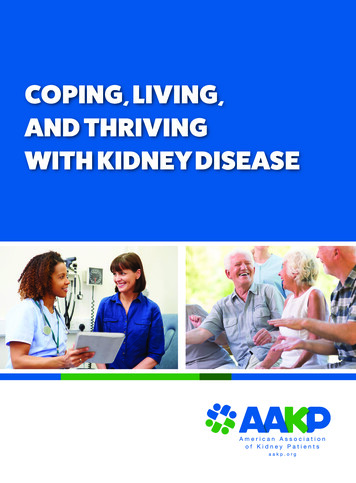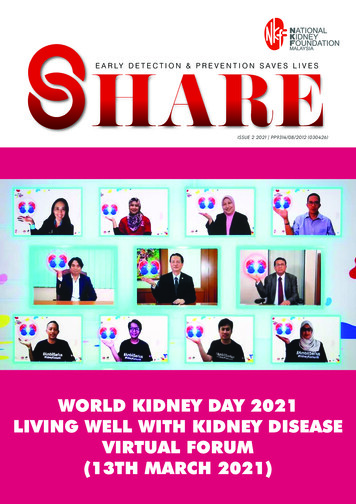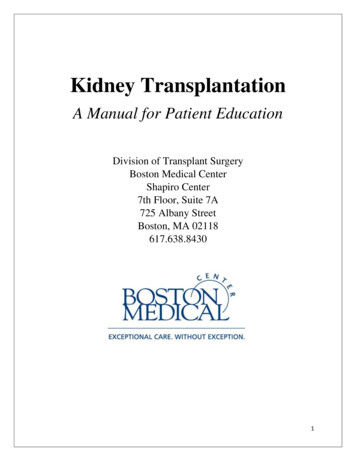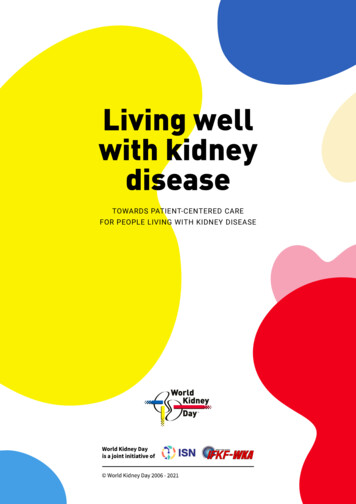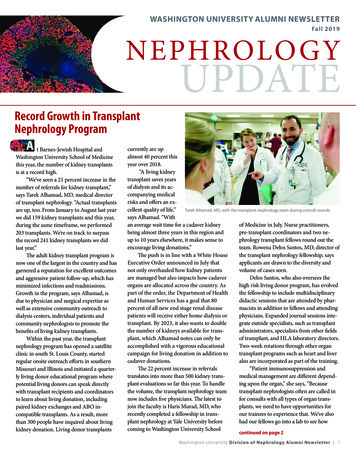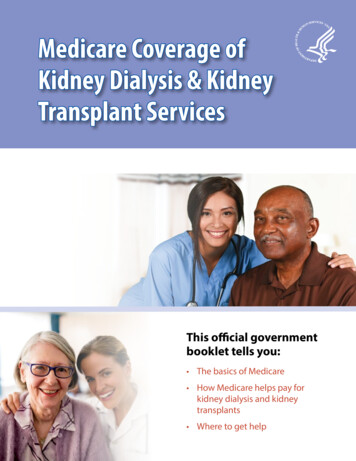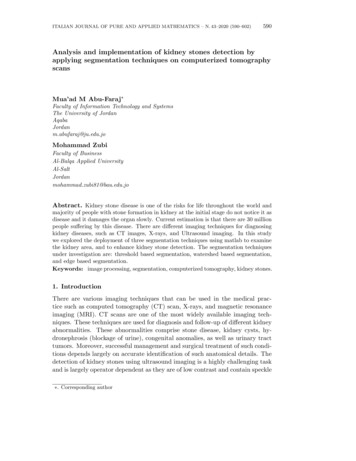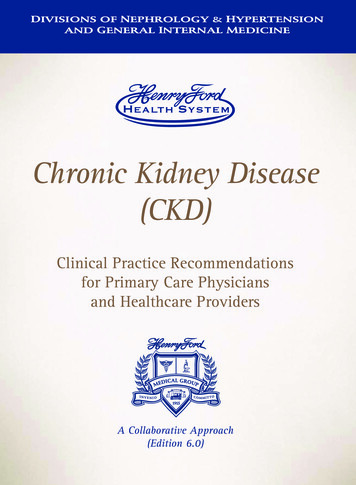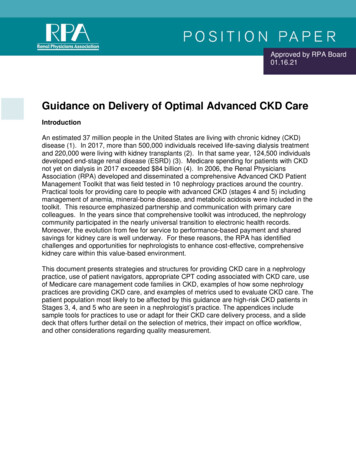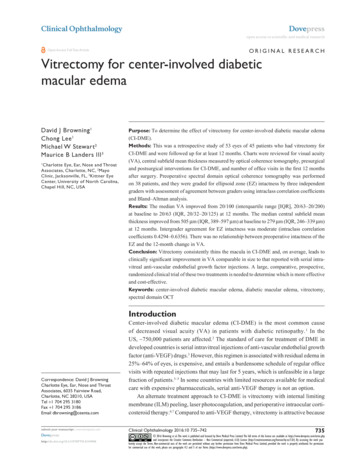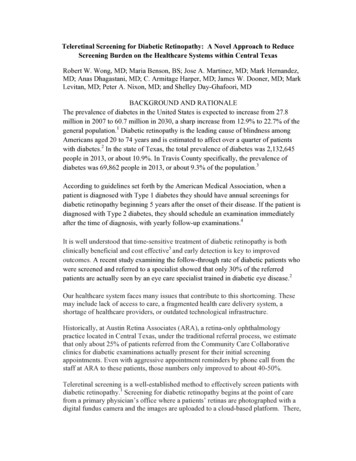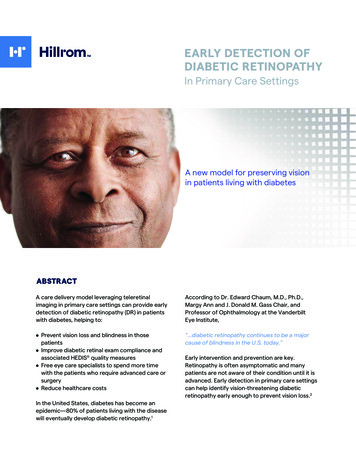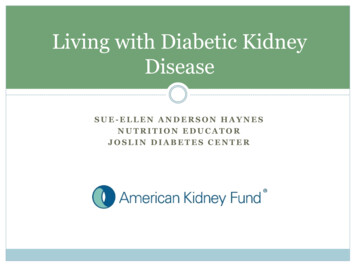
Transcription
Living with Diabetic KidneyDiseaseSUE-ELLEN ANDERSON HAYNESNUTRITION EDUCATORJOSLIN DIABETES CENTER
Thanks to our speaker! Sue-Ellen Anderson Haynes Registered Dietitian Nutritionistand Certified Personal Trainerwith interest and specialties indiabetes management Works at Joslin Diabetes Centeras a Nutrition Educator
ObjectivesTHE ROLE OF OUR KIDNEYS, AND HOW CHRONIC KIDNEYDISEASE (CKD) AND DIABETES ARE CONNECTED.THE RISK FACTORS, AND WAYS OF PREVENTING DIABETICKIDNEY DISEASE (DKD).LIFESTYLE APPROACHES, INCLUDING NUTRITION THERAPY,FOR MANAGING AND IMPROVING DKD.
What Do The Kidneys Do? Remove waste Regulate water balance Balance chemicals Produce hormones Maintain bone health
How are CKD and Diabetes connected? Diabetes Blood sugar (glucose) control according to the American DiabetesAssociation (ADA):fasting 70-130 mg/dL and 2 hrs after meals are less than 180mg/dL A1C less than 7 High blood glucose, poor controlFasting BG 130mg/dL, 2hrs after a meal 180mg/dL A1C greater than 7 Values that are consistently out of range Leads to kidney (renal) disease
How are CKD and Diabetes connected? Heart problems Eye issues Poor circulation and healing Lowered kidney function *
How are CKD and Diabetes connected? eGFR (Glomerular Filtration Rate) Shows how well your kidneys are currently filtering waste The value does not improve Normal GFR is about 100-130 Albumin/Creatinine Measure of how much protein is in your urine Less protein in urine, less damage to kidneys Normal range is under 30 mcg/mg 30-300 microabluminuria, 300 or more macroalbuminuria Can improve with medication
How are CKD and Diabetes connected? CKDcan be identified in two ways Kidneydamage over 3 monthsstructure or functional changes of the kidney with/withoutelevated GFR urine/blood test abnormalities With/without kidney damage for 3 months or more GFR 60 CKDhas 5 stages (1 to 5) Stagesget progressively worse as kidney damage increasesand GFR decreases Stage 5 is kidney failure GFR 15 (or dialysis)
Complications of Kidney Disease Lowered Kidney Function may include: Iron deficiency anemia Mineral-bone disease Hyperkalemia Too much potassium- affects the heartToxic build-upSwelling and fluid retention
So what is Diabetic KidneyDisease (DKD) ?“LONGSTANDING AND/OR POORLYCONTROLLED DIABETES THAT CAN RESULTIN A TYPE OF CKD KNOWN AS DIABETICKIDNEY DISEASE”
Diabetic Kidney Disease (DKD) Involves: protein in urine (macro-albuminuria), worsening high blood pressure poor blood glucose control genetic background
Risk factors for DKD Race Rate is increasing among Native American, Hispanic, andBlack cultures Blacks 36x more like than whites Diabetes Genetics family history Age Smoking Existing complications from diabetes Eye or nerve damage increase likelihood
Preventing and Managing DKD Screening Urine test Blood test Lipid levels Hemoglobin Blood markers for bone and mineral health
Preventing and Managing DKD Monitoring Check your blood pressure 140/80, with DKD 130/80 or 130/70Check blood glucose and log your numbersA1C 7 Fasting Goal: 70-130 or 90-130 2-hours Post Meal: 180 These values may vary with dialysis Use Continuous Glucose Monitor (CGM) if neededYour health care team will monitor certain labs 2-3 times/yearLifestyle and diet modification
How do you manage or improveDKD?LIFESTYLE CHANGES
Nutrition and Diabetes Foods that affect blood sugar Protein Minimal effect on blood glucose (sugar) Carbohydrate Large effect on blood glucose Fat Large amounts can effect blood glucose later on
Nutrition and Diabetes Carbohydrate Foods Bread Cereal Pasta Rice/Grains Starchy Vegetables Fruit Beans Juice Soda Sugary Desserts
Carbohydrate Counting
Typical Carbohydrate Requirement Male: 45-60/meal, 15-20/snack Female: 30-45/meal, 15/snack
Lifestyle Changes Counting carbohydrates Measuring food Eat more meals from home Exercise! 150 min/week moderate intensity exercise Strength training Walk after meals
What does having diabetes andkidney disease mean? Same principles as managing your diabetes Medication Monitoring Modification of diet and lifestyle Slight changes to: Medication Some may be added or removed Monitoring Your provider will monitor additional labs Modification Food intake will change slightly
Dietary Concerns for patients withKidney Disease Sodium Fluid Protein Potassium Phosphorus
Modification of Food Intake Same balanced plate Choose fresh foods from home Carbohydrate choice may change Vegetable choice may change Fruit choice may change Dairy products may be limited Protein may be restricted
Low Sodium DietLow Sodium FoodsHigh Sodium Foods Fresh fruits Fresh Vegetables Low sodium canned goods Grilled, Roasted meats Tips: Cook fresh foods, limit packaged products, be aware when diningout, stick to the basics, choose low salt soups and canned goods
Fluid Needs depend on Stage of kidney disease Blood pressure Swelling present Fluid Intake Liquid at room temp Water Juice Soda Coffee, Tea Broth Ice cubes
Protein Protein may be limited – ask your provider What are protein foods? Walk/Roam Swim Fly Vegetarian Protein Serving 3-4 oz. 1 oz. protein 7 g 3 oz. 21g deck of cards
PotassiumLow Potassium Foods 120mg / servingHigh Potassium Foods 250mg / serving
PhosphorusLow Phosphorus FoodsHigh Phosphorus Foods
Tips for Reducing PhosphorusTry eating:Instead of:1 cup unenriched rice milk1 cup milk1 oz. cream cheese1 oz. Neufchatel cheese1 oz. cheddar cheese½ cup pudding made with nondairycreamer½ cup pudding12 oz. diet ginger ale, or lemon-limesoda12 oz. diet cola½ cup cream of wheat½ cup oatmeal½ cup corn or rice cereal½ cup bran cerealUnsalted popcorn or pretzelsHandful of nuts
Sample Renal DietSample 1White toast, 2 slicesTrans fat free margarine, 1 tbsp.Cranberry juice, 1/3 cupCoffee/Tea, 8 oz.Sample 2Cornflakes, 1 cup Unenrichedrice milk (or non-dairycreamer), ½ cup Plums, 2Coffee/Tea 8 oz.Lunch (45 g carb)Grilled salmon, 3 oz. 2/3 cuppastaMixed green salad, 1 cup Oil andvinegar dressing, 2 tbsp.Grapes, 15 medium Diet gingerale, 8 oz.Tuna Sandwich:Low sodium/water packedTuna, 3 oz.Mayonnaise, 1 tbsp. Choppedonions, 1 tbsp. Choppedcelery, 1 tbsp. Kaiser roll, 1Apple, 1 medium Dietlemonade, 8 oz.Snack (15 g carb)1 pearFruit cocktail, ½ cupDinner (60 g carb)Broiled garlic shrimp, 4 oz. Rice, 2/3cupAsparagus, 4 spearsDinner roll, 1Trans fat free margarine, 1 tbspPineapple chunks, ½ cup Diet rootbeer, 8 oz.Baked pork chop, 4 oz.Noodles, 2/3 cup Steamedbroccoli, ½ cup French bread,1 sliceTrans fat free margarine, 1 tbspCherries, 1 cupWater, 8 oz.Snack (15 g carb)Graham crackers, 3 squaresVanilla wafers, 6Breakfast (45g carb)
Summary Get regular check ups to monitor lab values & BP Take your medication(s) as prescribed Improve blood glucose control & monitor BG daily Lower your blood pressure Follow your meal plan and adjust when needed Exercise regularly and maintain a healthy weight Stop smoking
Questions?
Join us for next month’s webinar!Paired Kidney Exchanges and Opportunitiesfor Kidney Transplant in Minority PatientsFriday, December 91-2 p.m. (ET)Join us to learn about: The paired kidney exchange process ABO compatibility in transplantation The need for more live donor kidneytransplants in the minority communityGo to www.KidneyFund.org/webinars to learnmore and register!
Shows how well your kidneys are currently filtering waste The value does not improve Normal GFR is about 100-130 Albumin/Creatinine Measure of how much protein is in your urine Less protein in urine, less damage to kidneys Normal range is under 30 mcg
